Engines included a 1995cc with 120bhp (8
valve, dohc with balancer shafts), a 1995cc turbo with 165bhp (also 8 valve
with intercooler), a 2849cc V6 with 147bhp and a 2445cc turbo diesel with
100bhp (also with intercooler)
In 1986 the range was extended by the addition
of two new versions. An estate version, the Station Wagon, designed by Pininfarina featured some interesting touches
such as the roof trailing edge spoiler. At the opposite end of the range from the estate came the new 8.32 - which had a
2927cc V8 32 valve Ferrari engine under the bonnet,
with 215bhp (named after 8 cylinders, 32 valves). This version had slightly modified external trim,
revised (much more luxurious) internal trim, a
retractable bootlid spoiler, different steering (ZF electrically controlled assistance), modified suspension
and uprated brakes. A limousine version, stretched by 300mm with the addition of an extra side window in the B-pillar, was introduced in 1987.
Shortly after the launch of the Thema, in 1985, Zagato proposed a
station wagon based on that car. In the end it was Pininfarina's design which won approval
and entered production.
In 1986 Boneschi showed the 'Gazzella', basically a three door version of the Thema.
Production of the last Thema's ceased in
1994, replaced by the Kappa.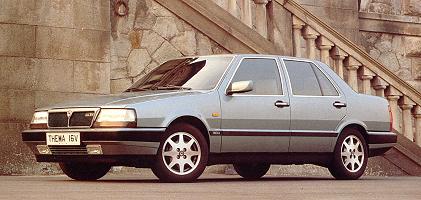 Introduced
in 1984, the Thema was the result of a co-operation between FIAT/Lancia
(also the Croma), Alfa Romeo (the 164)
and Saab (the 9000). A conventional three-box, four door saloon, with a
drag coefficient of 0.32 and designed by Giugiaro, the Thema marked Lancia's
return to the upper market segment. As such it was well equipped with a wide range of standard and optional features such as air
conditioning, heated seats, electric sunroof, leather upholstery etc.
Introduced
in 1984, the Thema was the result of a co-operation between FIAT/Lancia
(also the Croma), Alfa Romeo (the 164)
and Saab (the 9000). A conventional three-box, four door saloon, with a
drag coefficient of 0.32 and designed by Giugiaro, the Thema marked Lancia's
return to the upper market segment. As such it was well equipped with a wide range of standard and optional features such as air
conditioning, heated seats, electric sunroof, leather upholstery etc.
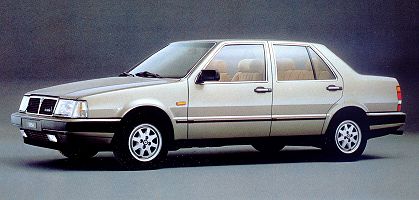 In 1988 all the four cylinder petrol engines
got 16 valves (except the base 2000 model), the exterior design was modified (easily recognisable by the front indicators being a horizontal strip under the headlights),
a hydraulic clutch was adopted and both self-levelling and electronically
adjustable suspension systems became available. In 1992 the 2000 (now 16V)
normally aspirated engine also gained variable geometry intake ducts, the
turbo was tuned for slightly more power (up to 205bhp from 185bhp)and the
V6 adopted a version of the 3000 Alfa Romeo unit. Some external changes
were also made (the most noticeable being the use of vertical strakes in
the front grille).
In 1988 all the four cylinder petrol engines
got 16 valves (except the base 2000 model), the exterior design was modified (easily recognisable by the front indicators being a horizontal strip under the headlights),
a hydraulic clutch was adopted and both self-levelling and electronically
adjustable suspension systems became available. In 1992 the 2000 (now 16V)
normally aspirated engine also gained variable geometry intake ducts, the
turbo was tuned for slightly more power (up to 205bhp from 185bhp)and the
V6 adopted a version of the 3000 Alfa Romeo unit. Some external changes
were also made (the most noticeable being the use of vertical strakes in
the front grille).
Technical Details
| Driveline | transvere engine at front with front wheel drive |
| Engines | 1995cc dohc four cylinder (8 and 16 valve version)
1995cc (84x90mm) dohc 16V turbocharged & intercooled four cylinder with 181bhp @ 5,500rpm 2849cc (91x73mm) sohc V6 with 147bhp @ 5,000rpm 2499cc turbodiesel 2927cc dohc 32V V8 |
| Suspension | front : MacPherson strut with telescopic dampers and coil springs plus anti-roll
bar
rear : MacPherson strut with telescopic dampers and coil springs plus anti-roll bar self levelling rear suspension wheelbase : 2660mm track (front/rear) : 1490mm/1482mm (turbo 16V : 1494mm/1484mm) |
| Brakes | front : discs (ventilated on some models)
rear : discs handbrake operating on the rear via cable dual hydraulic circuit with servo assistance ABS optional |
| Gearbox | 5 speed manual
3 speed automatic |
| Steering | Rack and pinion with power assistance |
| Empty weight | ie turbo : 1150kg
V6 : 1160kg (automatic : 1190kg) turbo diesel : 1240kg 16V turbo (1988) : 1285kg (kerb) |
| Dimensions | Saloon, Station Wagon and Limousine. |
Click here for a drawing of the floorpan and structure of the Thema, together with the main mechanical subgroups.
Performance
| model | max speed | 0-100km/h | standing km | braking dist from 100km/h |
| ie turbo (8V) | 220 km/h | 7.3 sec | 28.0 sec | 44.6 m |
| turbo ds | 186 km/h | 10.8 sec | 32.4 sec | 46.5 m |
| V6 | 211 km/h | 8.4 sec | 29.7 sec | 45.9 m |
| ie turbo (16V) | 227 km/h | 6.9 sec | 28.0 sec | 52.3 m (from 110km/h) |
| 8.32 | 7.2 sec |
Tuning
There are three main areas to concentrate on, the engine (and transmission), the brakes and the suspension and then various other details. These three should be done together since they complement each other, not all of one and none of another !
1. The engine.
Before modifying the engine it is worthwhile
filling it with a good quality synthetic oil and fitting new spark plugs.
An engine oil additive may also be used.
The first improvements are relatively simple.
The air filter can be replaced for an aftermarket item which will help
the engine breathe more freely, the types which completely replace the
airbox are best, and the exhaust can be replaced for one which will restrict
the exit of the gases less. Replace the whole system, not just the back box.
On the Thema turbo's the job of increasing
the power is usually done by raising the boost pressure, but do not be
tempted to raise it too far or the fuelling will not be able to cope and
the engine will run weak. Water spray on the intercooler is also worth
considering, switched by either an air temperature sensor (the ideal solution)
or bay a MAP sensor (the easy solution). Consider also adding an octane
boosting product to the fuel on cars with increased boost levels, it will help the ignition cope.
Other things to do should include fitting
a cold air intake, a large diameter pipe (minimum 5cm) to provide air from
outside the engine bay to the air filter. The exhaust manifold can also
be lagged with thermal cloth or tape to keep the exhaust gases hotter (and
thus reduce back pressure) and also to keep the underbonnet (and hence
intake and fuel) temperatures lower.
Further modifications require the machining
of the cylinder headand/or cylinder block (which will not be dealt with
here since it is not normally a DIY job) after which it may be worth fitting
an oil cooler. If overheating is a problem due to the increased power output
then Regarding the transmission the main requirement
is to uprate the clutch to handle the increase in power and torque achieved
though the engine modifications. Friction plates can be purchased with
improved materials and heavier duty pressure plates are also available.
Whilst doing this it is worthwhile lightening the flywheel.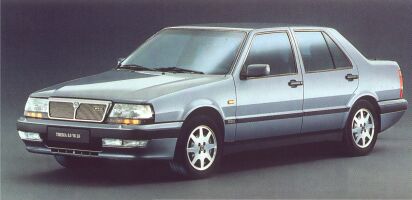 Probably
the most effective modification (short of engine rebuilds!) is to replace
the electronic control unit (or 'chip'). For the Thema availability of
off-the-shelf units is not good (although there are some), so useage of a unit designed for any engine
is required which will mean some programming and useage of a rolling road.....
A camshaft change will also significantly improve the power and torque,
but attention must be paid to the characteristics since some camshafts,
usually those with the best absolute figures, are not very driveable except on a race circuit.
Probably
the most effective modification (short of engine rebuilds!) is to replace
the electronic control unit (or 'chip'). For the Thema availability of
off-the-shelf units is not good (although there are some), so useage of a unit designed for any engine
is required which will mean some programming and useage of a rolling road.....
A camshaft change will also significantly improve the power and torque,
but attention must be paid to the characteristics since some camshafts,
usually those with the best absolute figures, are not very driveable except on a race circuit.
The high tension leads can also be replaced with performance ones.
 a
small hole can also be drilled through the plate in the thermostat.
a
small hole can also be drilled through the plate in the thermostat.
2. The brakes.
Initially it is relatively easy to replace
the brake discs with drilled and grooved items, and the pads for a harder
compound. The latter should not be too hard (ie no race pads on the road)
or they will not function effectively at the normal 'road' operating temperatures.
Stainless steel braided flexible hoses will improve the pedal feel and
reduce the chance of damage whilst DoT5 fluid (not silicon) will increase
the temperature at which it can operate effectively. If the brakes are
getting too hot the dustguards can be removed and/or ducts fitted, taking
air from behind the front bumper.
If more serious braking is required the
next modification would be to increase the disc size. It is possible to
use larger discs with a bracket allowing use of the production callipers,
or alloy four pot callipers can be fitted.
In order to improve the balance of the
car under braking it is desireable to be able to adjust the balance of
braking from front to rear (and vice versa). This can be accomplished by
fitting a bias valve in the line to the rear brakes, usually in a position
so that it can be reached from the drivers seat.
3. The suspension.
The easiest improvement,and the one which
will probably bring the single most noticeable change, is to replace the
full set of dampers and springs. A variety of kits are available which
include four matched dampers and springs. Top adjustable units are compromised,
but are good for road and track day cars since it allows the suspension
to be adjusted between these two, rather different, requirements. Coil
over units add more adjustability and can be purchased outright, or can
be made from standard There are then two other main suspension
aims; to reduce the flexiblity in the suspension and to increase the stiffness
of the car, both of which aim at more accurate control of the wheel movement.
To reduce the flexibility it is possible to fit nylon bushes instead of
the normal production rubber items, or if perfection is desired the suspension
can be fitted with metallic bearings (rose joints / rod ends). Spherical
bearing top mounts can also be used. To stiffen the car it is most popular
to fit strut braces. These can be fitted to the front and rear. For more
extreme cases a rollcage can be fitted.....
Into this category also fall the choice
of wheels and tyres. With an increase in power it can be necessary to fit
larger tyres (thus requiring larger wheels) but the temptation to fit the
biggest possible should be resisted. Consideration should be given to fitting
a wider tyre on the front (since they provide traction and steering) but
keeping the standard, or a wider but not as wide as the front, tyre at
the rear. This will improve the balance of the car.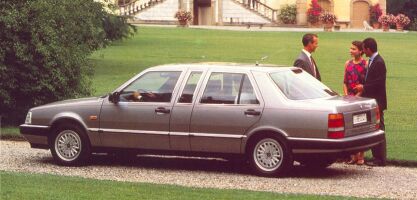 dampers
by welding a threaded sleeve to the standard tube.
dampers
by welding a threaded sleeve to the standard tube.
4. other things.
Other modifications worth considering include fitment of a shift light (and rev limiter if there is not one as standard), higher power bulbs in the headlights (if you are going to go faster you need to see further) and installation of a quicker steering rack.
Buying / Selling
The Thema offers excellent value for money.
Much underrated, the value of second hand cars is now very, very low and
they offer lots of space, a reasonable level of luxury, and in 16V or turbo
form, a lot of go. The 8.32 is another story, but prices are correspondingly higher.
Some tips to do before selling :
(they may seem obvious, but most people don't do them and thus are in a
weaker bargaining position)
Tidy inside the car thoroughly : hoover
the floor, empty all pockets, ashtrays (wash), glove compartment etc...,
wipe the trim with a If the car has been standing give it a
good run - this will clear out the engine (reduce exhaust smoke), put a
shine on the brake discs and loosen up any joints that may otherwise make some noises.
'Back to black' products are very effective
at temporarily restoring bumpers and trim. This makes a big difference
to any car. Do it a week before you expect people to view the car, otherwise
it may be a bit too obvious !
Jetwash under the car, especially under
the engine and in the wheelarches. The prospective buyer may be an enthusiast,
and this makes it easier for them to see what they want to check.
Obviously wash the car and clean the windows !
If you are going to buy a car always
check the following :
The bodywork should not be a major issue,
but check around just in case. The wheelarches, suspension and engine mounts,
sills, door pillars, scuttle panel and the floor can be easily inspected.
If a sunroof is fitted check around the edge. Check that there are no mismatching
panels, large areas of discolouration or signs of fresh paint. Compare
the paint colour in the engine bay with that of the exterior.
Check for a damp carpet or the presence
of mould - if the carpet is damp then the floor is almost certainly corroded.
Check the brake pedal does not go to the
floor if pressed hard for a long time and check the gearchange for clean engagement.
The engine should be run up to temperature,
check the exhaust for smoke (especially on the turbo models), the condition
of the breather (look for mayonaise), the condition of the oil filler cap
(again white deposits can indicate a head gasket problem...) and the colour
of the coolant (preferably not brown!). If the car has an oil pressure
guage this should not drop below 1 bar at idle, and should be around 3
to 4 bar at speed. Listen to the noise of the engine, then depress the
clutch and engage first gear. Whatever noise has disappeared was coming
form the gearbox, what remains is from the engine. Check the condition
of the engine oil using the dipstick. It should be a lovely golden
-brown, darker is also ok but avoid the black stuff (except in dieels where this is the norm).
Check tyre wear, uneven patterns could imply a bent chassis.
Always take it for a test drive. Check
that the car tracks in a straight line with no steering input. Find a large
open area and complete several lock to lock turns (also in reverse), listening
for any noises. Try the handbrake when moving - seized rear callipers will
mean uneven braking or no braking.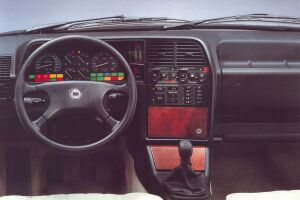 damp
cloth, give the cockpit a good airing to get rid of any odours ! Reset
the trip meter to 00000 - it is a pleasant (subconcious) surprise.
damp
cloth, give the cockpit a good airing to get rid of any odours ! Reset
the trip meter to 00000 - it is a pleasant (subconcious) surprise.
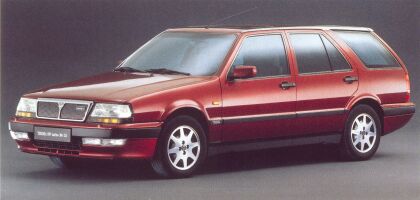 Check
the main electrical functions - wipers, windows, lights etc... try putting
the main beam and wipers on at the same time. Check the headlight reflectors
for rust and the glass for cracks.
Check
the main electrical functions - wipers, windows, lights etc... try putting
the main beam and wipers on at the same time. Check the headlight reflectors
for rust and the glass for cracks.
Thema comment form
Your Comments
I have had three Themas in
my time and I still can't get enough of them. (1994 16v, Patrick, UK)
Drove a Thema TD for 5 years
and loved every minute of it. Beautiful, discreet ( BCBG, as they say in
French )fun to drive, and much better equipped than the Teutons. Managed
to convince an all time German marques supporter friend to switch to Thema
also. We both now drive Kappa for some time already. (Hawkeye, Belgium)
I have a Thema V6 for
9 years now,covering 170 000 km.Between 155000 and 165000 I had to repair
suspension,brakes,AirCon!!! very expensive,2 times exhaust--thats ist,the
engine runs smooth than ever--it was a very comfortable long distance runner
all the time. (FK)
Recently bought a "Lancia
Thema Turbo 16V LX" 1993 model. This is the best car I have EVER driven!
Extremely well built, fast as lightning, and comfortable. (Vetle, Norway)
I bought a 16V VIS 150 CV
(07/1993) in Jan 2000. I couldn't expect nothing more from a car. Fast
(215 Km/h), comfortable, powerful, always ready under my right foot. Sometimes
I'd want more from 'her', maybe I could buy a 16V Turbo 205 CV as my next
car! Its only bug is that Lancia don't build it anymore! (Raffaele, Italy)
The best car I've ever had. nice to drive and cheap to buy and perfect to look at! the bad things are electrical problems and heavy thirst.
I just bought a '92 2.0 i.e. turbo and i should say, I love driving it. It is very fast, and a smooth ride.(Kledi, Albania)
I've Thema 2,0 16v Turbo for 1 year after 9 cars before. Thema is the best car of world. Now car covering 230000 and stil is faster then some bikers. (PK, Poland)
Have owned a 16v thema for 5 years. Has been the oldest and
cheapest car i have bought and owned but by far the best. I have had no
major problems with my Thema which has now covered 117000 miles and is used
every day. Highly recommended. (Fraser G)
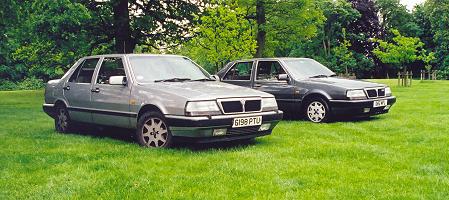 good car strong engine (1988 thema turbo 8v, Mike, UK)
good car strong engine (1988 thema turbo 8v, Mike, UK)
 I owned a Thema turbo 16v
LX for two years. It is the strongest most wild car I had ever driven.
It is faster in mid acceleration then a Subuaru Impreza. Its only fault
is electric problems and it is sensitive to fuel quality (since I'm from
Israel the fuel here is bad). If you want to modify the car first modify
the suspension make it stiffer and the brakes. All in all its a great car.
I owned a Thema turbo 16v
LX for two years. It is the strongest most wild car I had ever driven.
It is faster in mid acceleration then a Subuaru Impreza. Its only fault
is electric problems and it is sensitive to fuel quality (since I'm from
Israel the fuel here is bad). If you want to modify the car first modify
the suspension make it stiffer and the brakes. All in all its a great car.
There is also a list of all our picture galleries (including museums, motorshows and various events).
Wallpapers/Desktop Backgrounds of numerous Lancia's, including the Thema, are available to download.
See also our Lancia advertisements gallery, where several adverts can be seen.![]() For books on Lancia see our Online Bookstore
For books on Lancia see our Online Bookstore
Use the buttons at the top to navigate
further, or
Copyright © 2000 to 2008 CarsfromItaly